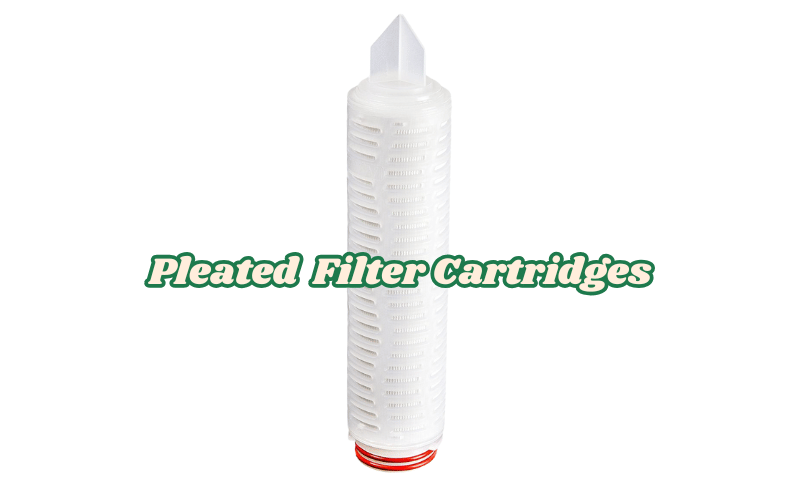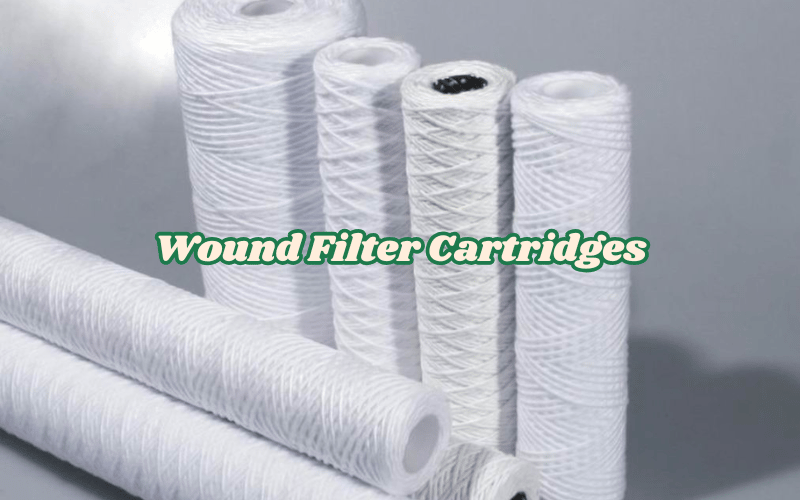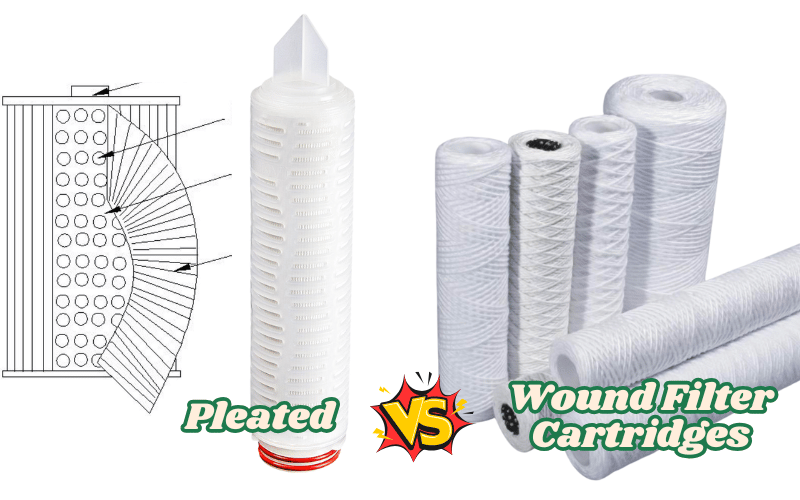Filtration is a critical process in industries ranging from water treatment to pharmaceuticals, ensuring purity, efficiency, and product safety. Among the most commonly used filter types are pleated and wound filter cartridges, each designed for specific applications and performance requirements. While they may look similar at a glance, their construction, efficiency, and optimal use cases differ significantly.
For industries where contamination control is non-negotiable—such as food and beverage, chemical processing, or medical manufacturing—selecting the correct filter cartridge can mean the difference between flawless production and costly downtime.
Let’s break down the key differences between pleated and wound filter cartridges, their advantages, and where each excels.
Table of Contents
ToggleUnderstanding Pleated Filter Cartridges
What Are Pleated Filter Cartridges?
Pleated filter cartridges are advanced filtration components designed to remove fine particles and contaminants from liquids or gases. They are constructed with pleated filter media, typically made from materials such as polyester, polypropylene, or cellulose, which is folded into a series of ridges. This pleated design maximizes the surface area available for filtration, allowing the cartridge to trap a higher volume of particles while maintaining efficient flow rates. As fluids or gases pass through the pleated layers, contaminants are captured, ensuring a clean and purified output. These cartridges are particularly valued for their ability to deliver consistent and precise filtration in demanding environments.
Key Features of Pleated Filter Cartridges
- Expanded Surface Area: The pleated design increases the filter media’s surface area significantly compared to flat or non-pleated filters. This allows for higher dirt-holding capacity and longer operational life without frequent replacements.
- High Filtration Precision: Pleated cartridges are capable of capturing particles as small as 0.1 microns, making them ideal for applications requiring ultra-fine filtration.
- Reusable Options: Many pleated filter cartridges are designed to be cleaned and reused multiple times, depending on the material and application. This feature reduces operational costs and minimizes environmental impact.
Common Applications of Pleated Filter Cartridges
Pleated filter cartridges are indispensable in industries where precision and reliability are paramount. Some of their most common applications include:
- Pharmaceutical Industry: Used to filter out bacteria, endotoxins, and other microscopic contaminants to ensure the safety and purity of medicines and vaccines.
- Electronics Manufacturing: Essential for removing ultra-fine particles from process fluids to protect delicate components like semiconductors and circuit boards.
- Food and Beverage Processing: Ensures the removal of impurities from liquids such as water, juices, and syrups, maintaining product quality and meeting stringent regulatory standards.
- Water Treatment: Utilized in pre-filtration and polishing stages to remove sediments, microorganisms, and other impurities from water supplies.
With their ability to deliver high-efficiency filtration and adaptability across various industries, pleated filter cartridges are a trusted solution for applications requiring superior performance and reliability.

Exploring Wound Filter Cartridges
What Are Wound Filter Cartridges?
Wound filter cartridges are a type of depth filtration solution designed to capture contaminants throughout the entire thickness of the filter media. These cartridges are constructed by tightly winding a continuous strand of material, such as polypropylene, cotton, or fiberglass, around a central core. The winding pattern creates a gradient structure, with tighter layers on the inside and looser layers on the outside. This design allows the cartridge to trap particles of varying sizes, making it highly effective for applications requiring high dirt-holding capacity and consistent filtration performance.
Key Features of Wound Filter Cartridges
- Depth Filtration: Unlike surface filters, wound cartridges provide depth filtration, capturing particles at multiple layers within the filter. This ensures efficient removal of larger particles while maintaining flow rates.
- High Dirt-Holding Capacity: The gradient density structure enables these cartridges to hold a significant amount of debris, reducing the frequency of replacements and extending operational life.
- Durability and Cost-Effectiveness: Wound cartridges are designed to withstand high-pressure environments and are often more affordable compared to other filtration options, making them a practical choice for many industries.
Common Applications of Wound Filter Cartridges
Wound filter cartridges are widely used in industries where robust filtration and high dirt-holding capacity are essential. Key applications include:
- Water Treatment: Ideal for removing sediments, rust, and other large particles from municipal and industrial water supplies.
- Oil and Gas Industry: Used to filter out contaminants from drilling fluids, lubricants, and other process liquids, ensuring equipment protection and operational efficiency.
- Chemical Processing: Effective in filtering viscous fluids and protecting downstream equipment from particulate contamination.
- Food and Beverage Production: Commonly used for pre-filtration to remove larger impurities before fine filtration stages.
With their rugged construction, cost-efficiency, and ability to handle high levels of particulate matter, wound filter cartridges are a reliable choice for a wide range of industrial and commercial filtration needs.

Key Differences Between Pleated and Wound Filter Cartridges
Filtration Efficiency
Pleated filter cartridges are designed for high-precision filtration, capable of capturing particles as small as 0.1 microns. Their pleated structure provides a large surface area, allowing for fine filtration without compromising flow rates. This makes them ideal for applications requiring ultra-clean outputs, such as pharmaceuticals and electronics manufacturing.
In contrast, wound filter cartridges are better suited for depth filtration, as they capture larger particles throughout the multiple layers of their gradient structure. While they may not match the fine filtration capabilities of pleated cartridges, they excel in handling fluids with high levels of sediment or larger contaminants, such as in water treatment or oil and gas applications.
Dirt-Holding Capacity
Wound filter cartridges have a higher dirt-holding capacity due to their depth filtration design. The gradient density allows them to trap a significant amount of debris, making them suitable for environments with heavy particulate loads.
Pleated cartridges, while efficient at capturing fine particles, have a lower dirt-holding capacity compared to wound cartridges. They are better suited for applications where precision is the primary focus rather than handling large volumes of contaminants.
Lifespan and Maintenance
Pleated cartridges often have a longer lifespan in applications requiring fine filtration, as their large surface area reduces the frequency of clogging. Additionally, some pleated cartridges are reusable, allowing for cleaning and extended use, which can lower maintenance costs over time.
Wound cartridges, on the other hand, are typically single-use and must be replaced once they reach their capacity for holding dirt. However, their robust construction makes them durable in high-pressure environments, ensuring reliable performance until replacement is necessary.
Cost Considerations
The upfront cost of pleated filter cartridges is generally higher due to their advanced design and fine filtration capabilities. However, their reusability and longer lifespan can make them more cost-effective in the long run for applications requiring precision.
Wound cartridges are more affordable initially, making them a practical choice for industries with high filtration demands and frequent cartridge replacements. Their cost-effectiveness is particularly advantageous in applications where large volumes of contaminants need to be filtered.
Flow Rate and Pressure Drop
Pleated cartridges offer superior flow rates due to their expanded surface area, which minimizes pressure drop even during high-volume filtration. This makes them ideal for applications where maintaining consistent flow is critical.
Wound cartridges, while effective at handling high dirt loads, may experience a higher pressure drop as contaminants accumulate within the filter’s depth. They are better suited for applications where flow rate is less critical, and the focus is on durability and dirt-holding capacity.
By understanding these key differences, industries can select the most suitable filtration solution based on their specific operational needs and priorities.
Comprehensive Comparison: Pleated vs. Wound Filter Cartridges
| Feature | Pleated Filter Cartridges | Wound Filter Cartridges |
|---|---|---|
| Filtration Method | Surface filtration: Captures particles on the outer surface of the filter medium. | Depth filtration: Traps contaminants throughout the entire thickness of the filter medium. |
| Material Options | Polypropylene, Polyester, Nylon. | Polypropylene, Cotton, Polyester. |
| Durability | High durability, especially with polypropylene and polyester. | Durable but less rigid compared to pleated filters. |
| Chemical Resistance | Excellent (Polypropylene), Moderate (Polyester). | Good (Polypropylene), Limited (Cotton). |
| Eco-Friendliness | Not biodegradable. | Cotton options are biodegradable and eco-friendly. |
| Filtration Precision | High precision, suitable for fine filtration (micron ratings as low as 0.1ç¢m). | Effective for coarse filtration and capturing larger particles. |
| Dirt-Holding Capacity | Moderate. | High, suitable for environments with heavy sediment or particulate loads. |
| Flow Rate | High flow rates with minimal pressure drop. | May experience higher pressure drops compared to pleated filters. |
| Cost | Higher initial cost due to advanced design and materials. | More cost-effective, especially for bulk filtration needs. |
| Applications | Pharmaceuticals, Microelectronics, Food & Beverage. | Water Treatment, Oil & Gas, Chemical Processing. |
| Service Life | Longer service life due to larger surface area. | Shorter service life but handles higher debris volumes before clogging. |
Key Takeaways:
- Pleated Filters: Best for applications requiring high precision and fine filtration, such as pharmaceuticals and microelectronics.
- Wound Filters: Ideal for heavy sediment loads and cost-effective bulk filtration in industrial settings.
Maintenance and Replacement Tips for Pleated & Wound Filters
Proper maintenance is key to maximizing the lifespan of both pleated and wound filter cartridges. For pleated filters, regular backwashing (if applicable) and monitoring pressure drop can prevent premature clogging. Since they excel in fine filtration, avoiding excessive particulate loads will extend their service life. Wound filters, designed for depth filtration, can handle higher debris levels but should still be inspected for media unraveling or channeling, which reduces efficiency. Common signs that a filter needs replacement include increased pressure drop, reduced flow rate, or visible breakthrough of contamination.
A cost analysis reveals that while pleated filters may have a higher upfront cost, their longer lifespan in clean applications can make them more economical in the long run. Wound filters, though cheaper initially, may require more frequent replacements in high-contaminant environments. By tracking operating conditions and replacement intervals, businesses can optimize costs while ensuring consistent filtration performance. Implementing a scheduled maintenance plan helps avoid unexpected downtime and maintains system efficiency.
How to Choose the Right Filter Cartridge for Your Needs
Assess Your Filtration Requirements
The first step in selecting the correct filter cartridge is to define your filtration needs clearly. Consider the size of the particles you need to remove—applications requiring ultra-fine filtration, such as pharmaceuticals or electronics, may benefit from pleated cartridges, while processes dealing with larger contaminants, like water treatment, might be better suited for wound cartridges. Additionally, evaluate the required flow rate and pressure levels to ensure the cartridge can handle the operational demands without compromising performance. Matching the cartridge type to your specific application ensures optimal efficiency and reliability.
Consider Your Budget
When choosing a filter cartridge, it’s essential to weigh the upfront cost against long-term expenses. Pleated cartridges often have a higher initial price but can be more cost-effective over time due to their reusability and extended lifespan in precision applications. Wound cartridges, on the other hand, are more affordable initially and are ideal for industries with high filtration demands and frequent replacements. Understanding your budget constraints and operational priorities will help you strike the right balance between cost and performance.
Evaluate Environmental Factors
Environmental conditions play a significant role in determining the suitability of a filter cartridge. Consider factors such as operating temperature, chemical compatibility, and pressure levels. For instance, if your filtration process involves exposure to harsh chemicals or high temperatures, ensure the cartridge material—whether polypropylene, fiberglass, or another option—can withstand these conditions without degrading. Selecting a cartridge that aligns with your operating environment ensures durability and consistent performance.
Consult with Experts
For complex filtration systems or unique operational challenges, consulting with industry professionals can be invaluable. Experts can provide tailored recommendations based on your specific requirements, helping you navigate the wide range of options available. They can also assist in troubleshooting potential issues and optimizing your filtration setup for maximum efficiency. Seeking professional advice ensures that you make an informed decision and achieve the best results for your application.
FAQ: Pleated vs. Wound Filter Cartridges
Q: What is the difference between pleated and string-wound filter cartridges?
A: Pleated and string-wound filter cartridges differ primarily in their design and filtration approach. Pleated filters feature a folded design that increases the surface area, making them highly efficient at capturing fine particles and sediment. On the other hand, string-wound filters are constructed by winding layers of string around a core, creating a depth filter that excels at trapping larger sediment particles. This makes string-wound filters ideal for applications with high sediment levels, such as well water filtration.
Q: How does a pleated sediment filter work?
A: A pleated sediment filter operates by utilizing its folded design to maximize the surface area of the filter media. As water flows through the pleats, sediment particles are trapped within the folds, allowing cleaner water to pass through. This design not only improves filtration efficiency but also minimizes pressure drop, making it an effective solution for capturing fine particles while maintaining consistent water flow.
Q: When should I choose a wound filter over a pleated filter?
A: A wound filter is the better choice when dealing with high sediment loads or larger particles, such as in well water or industrial applications. Its depth filtration design allows it to hold more debris and handle higher levels of contamination. Conversely, a pleated filter is more suitable for applications that require finer particle removal and longer filter life, such as those in pharmaceutical or food and beverage processes.
Q: What are the common types of sediment filters available?
A: The most common types of sediment filters include pleated filters, string-wound filters, and melt-blown filters. Pleated filters are renowned for their high filtration efficiency and extended lifespan, while string-wound filters are particularly effective in capturing larger particles in high-sediment environments. Melt-blown filters, composed of layers of fine fibers, are ideal for applications that require consistent particle retention and depth filtration. Selecting the right type depends on your specific water quality and filtration needs.
Q: How does filter media affect filtration efficiency?
A: The type of filter media directly impacts the filtration efficiency and performance of a cartridge. Pleated filters often utilize synthetic or cellulose-based materials that are excellent for trapping fine particles, whereas string-wound filters typically employ polypropylene or cotton, which are better suited for capturing larger debris. The choice of media also influences the filter’s durability, chemical compatibility, and overall lifespan.
Q: How often should I change my water filter?
A: The replacement frequency of a water filter depends on several factors, including the type of filter, water quality, and usage. Pleated filters generally last longer than string-wound filters due to their larger surface area and higher dirt-holding capacity. Monitor your system for signs like reduced water pressure or declining water quality—these are indicators that it’s time to replace the filter.
Q: Can a pleated filter handle well water?
A: Yes, pleated filters are effective for healthy water, especially when designed to capture a wide range of particle sizes. Their large surface area allows them to trap fine sediment commonly found in well water. However, for high sediment loads, combining a pleated filter with a string-wound filter can enhance overall filtration performance and extend the lifespan of the pleated filter.
Q: What is the role of filter housings in water filtration systems?
A: Filter housings are essential components that provide structural support and protection for filter cartridges. They ensure a secure seal to prevent leaks and maintain proper water pressure and flow. Selecting the right filter housing is crucial for ensuring compatibility with your chosen filter type—whether pleated or wound with strings—and for providing the system operates efficiently under varying conditions.
Future Trends in Filtration: The Evolution of Pleated and Wound Filters
The future of filtration technology is being shaped by advanced materials, sustainability demands, and smart integration. Pleated filters, known for their high surface area and fine particle retention, are expected to incorporate nanofiber media for enhanced efficiency, capturing sub-micron particles while maintaining low pressure drops .
Meanwhile, wound filters, traditionally used for depth filtration, may evolve with hybrid designs combining synthetic and biodegradable fibers to improve dirt-holding capacity while reducing environmental impact . Both types will likely integrate IoT sensors for real-time monitoring, enabling predictive maintenance and optimized performance in industrial and medical applications . As industries strive for energy efficiency and adopt circular economy practices, reusable and recyclable filter materials will become the standard, ensuring compliance with increasingly stringent environmental regulations. The next generation of pleated and wound filters will not only meet but exceed evolving industry demands, balancing performance, sustainability, and smart functionality.
Conclusion
In summary, pleated and wound filter cartridges each offer unique advantages, with pleated cartridges excelling in precision filtration and reusability, while wound cartridges are ideal for high dirt-holding capacity and cost-effectiveness. The choice between the two ultimately depends on your specific application needs, such as particle size, flow rate, and environmental conditions. Carefully evaluating your filtration requirements or consulting with industry experts can help you select the most suitable solution for optimal performance and efficiency.


